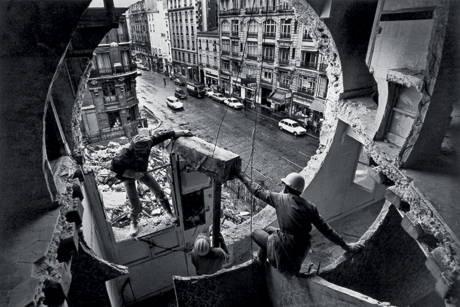Art Of The Day Weekly
#518 - from 7 June 2018 to 13 June 2018

Harry Gruyaert, Gordon Matta-Clark and Gerry Hovagimyan working at Conical Intersect, Rue Beaubourg, 1975 © Harry Gruyaert / Magnum Photos
IN THE AIR
And Matta-Clark dug up the city
PARIS - In 1975, just when the neighborhood of the Halles was been demolished in order to set up the future Centre Pompidou, a very special demolition team occupied a condemned building. They elegantly cut out the building’s façade to make a huge, circular opening, letting us guess if it was to be a porthole, or an eye on the city. The creator of this work was Gordon Matta-Clark, the son of the Surrealist painter Matta, a graduate in architecture. He had chosen to carry out spectacular operations in abandoned or decaying sites, like in the Bronx, and using the sole force of his muscles, criticize urban planning in his time, in situ. The famous video that immortalizes the case of the Halles (Conical Intersect) is shown during this exhibition that summarizes the itinerary of Matta-Clark, who died too young, in 1978, at age 35, from cancer. It focuses in particular on his interventions in Paris.
• Gordon Matta-Clark. Anarchitecte at the Jeu de paume, from 5 June to 23 September 2018.
EXHIBITIONS
Baselitz, questions about a body
COLMAR – 80 years, and still going strong – we could easily say. The German painter was celebrated all around, especially at the Fondation Beyeler in Basel, when he joined the honorable club the eighty-year old artists, but he has no intention of bowing out. As a matter of fact, this exhibition shows Baselitz’s most recent productions, which remain abundant and “physical” (certain large formats are nearly 25 m2 large! Nevertheless, the nearly 70 works presented here, dated from the last four years, reveal a tormented artist who questions his own aging body. Aside from the great masters whose presence is very strong in Colmar (Grünewald of course, and his Altarpiece from Issenheim, as well as Cranach and Dix), Baselitz appreciates the architects Herzog and de Meuron, who designed the museum’s extension, inaugurated in January 2016, as well as his own workshop on the shores of lake Ammersee in Bavaria.
• Corpus Baselitz at the Unterlinden Museum, from 10 June to 29 October 2018.

Victor Vasarely, Feny, 1973. Colección Carmen Thyssen-Bornemisza © Victor Vasarely, VEGAP, Madrid, 2018
Vasarely, a pioneering Op Art artist
MADRID – His name is linked to Op Art - or optic art – and to the galerie Denise René in Paris, who was his determined defender for more than half a century. Victor Vasarely (1906-1997), a pioneer, was Hungarian but accustomed to France, and shared this artistic adventure with companions such as Le Parc or Soto. But the exhibition at the Thyssen Museum is solely dedicated to his work, based in part on the corpus from his foundation in Aix-en-Provence, which experienced some troubled times, and in part on private collections, such as that of Carmen Thyssen-Bornemisza. It was already shown at the March foundation in Madrid shortly after his death, in 2000, and at the BBK room in Bilbao. Vasarely, who spent some time at the Bauhaus in Budapest, and was open to multiple collaborations, such as the one with Renault, suffered somewhat from an overexposure of his work.
• Victor Vasarely. El nacimiento del Op Art at the Thyssen-Bornemisza
FOUNDATIONS
Carmignac, art on an island
While the exhibition on Matta-Clark shows a radical criticism of architecture that influenced contemporary creators such as Frank Gehry, the Fondation Carmignac – recently inaugurated on the ultra-protected island of Porquerolles – shows how contemporary architecture is capable of successfully complying with drastic conditions. Regulations forbid all enlargements on the surface. The GMAA agency thus decided to go fetch the needed additional square meters underground, in order to present the roving presentation of nearly 300 works from the collection built up by financial tycoon Edouard Carmignac, and now led by his son Charles. The house was suspended in the air while the digging took place, and a source of light was imagined. The tenuous and trembling Mediterranean light filters through a glass plate covered with water, down into the white rooms where works by Lichtenstein, Warhol, and Basquiat – among others- are revealed to the visitor. Outside, under the pine trees, we encounter Hein’s labyrinth of mirrors, Nils-Udo’s marble eggs, Rondinone’s chromed statues: another world. A long time ago, this same setting was the stage for Pierrot le fou by Godard, with Belmondo. Those were other times…
• The Fondation Carmignac was inaugurated on 1st June 2018.
BOOKS
Fromanger, a taste for revolt
Where has the Revolution gone? Fromanger, born in 1939, was one of the main characters in May 68, at the popular workshop of the school of fine arts (“Beaux-Arts”), where the well-known posters were churned out. When the police squads (the infamous CRS) put an end to this little closet republic, it was again Fromanger who rolled out the celebrated “La police s’affiche aux Beaux-Arts, les Beaux-Arts affichent dans la rue” (The police make fools of themselves at Beaux-Arts, Beaux-Arts shows off in the street). This anecdote among many others holds a major place in the souvenirs the artist narrated during a friendly chat with journalist Laurent Greilsamer, known among other successes for a biography of Nicolas de Staël. We discover a man in revolt since his youth, who as a teenager had already tried to set his very strict high school on fire, and whose most recent criticisms are aimed directly at the public procurement system, in particular at the time of Jack Lang. His numerous friendships allowed him to rub elbows with such remarkable artists as Giacometti, Prévert, Foucault, Guattari or even Castel, the king of famous left-bank nights, under certain circumstances that at times seem worthy of a novel. One such story is the one of Giacometti, charmed by his nude at the Salon de Mai in 1964. But the organizers had tried to hide it, and he discovered it in the restrooms! Fromanger seems to have found a new type of serenity: he has been living for the last thirty years in the Tuscan countryside, near Sienna, where he meditates on the landscapes by the Lorenzetti brothers.
• Fromanger, de toutes les couleurs, by Laurent Greilsamer, Gallimard, 2018, 240 p., €25.
OPENINGS OF THE WEEK

TATOUÉ. ARCHIVE
8 June 2018 - LYON - Galerie Tator
The collective that invented an automatic tattooing machine
BERLIN - The contemporary art Biennale is being held from 9 June to 9 September 2018.
BRUSSELS - Three extra-European are being held under the label Cultures from 6 to 10 June 2018 (Bruneaf, BAAF et AAB).



